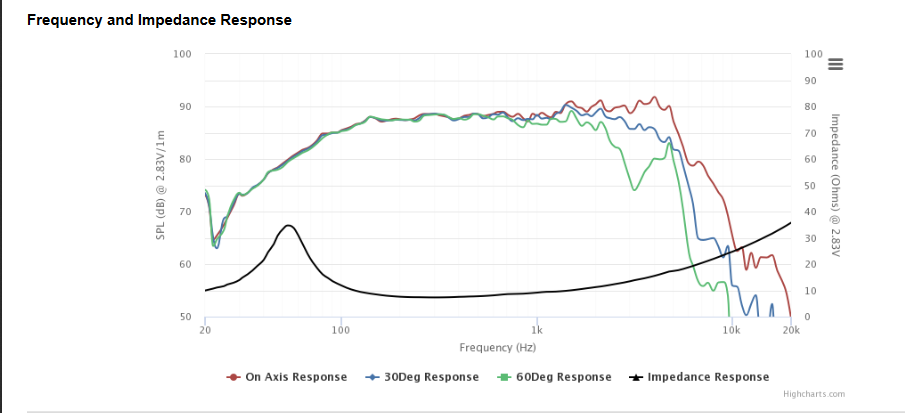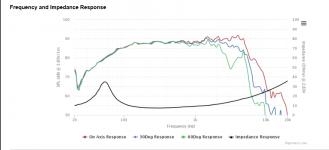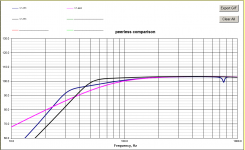Hey guys I'm having a very frustrating time putting together a set of speakers I'm working on. It's a bookshelf, Dayton BR1 bookshelf enclosures with Peerless drivers.
Tymphany 830874 6-1/2" PPB Cone HDS Woofer
Tymphany XT25TG30-04 1" Dual Ring Radiator Tweeter.
I'm running active, crossing over everywhere from 1500hz up to 5000, right now I have the mids just running full range.
Speakers are being powered by a zoudio 4 channel amp with dsp. 50wrms x4 @4oms.
I think one hurdle I'm facing is that my woofers are 8ohms, tweeters are 4ohms.
but whatever I do The sound is very muddy and removed. Question: Should my midwoofers sound GOOD just hooked up and running full range??? they sound terrible... What could I be doing wrong??
I wonder if my amp is just junk ??? not enough power?
Tymphany 830874 6-1/2" PPB Cone HDS Woofer
Tymphany XT25TG30-04 1" Dual Ring Radiator Tweeter.
I'm running active, crossing over everywhere from 1500hz up to 5000, right now I have the mids just running full range.
Speakers are being powered by a zoudio 4 channel amp with dsp. 50wrms x4 @4oms.
I think one hurdle I'm facing is that my woofers are 8ohms, tweeters are 4ohms.
but whatever I do The sound is very muddy and removed. Question: Should my midwoofers sound GOOD just hooked up and running full range??? they sound terrible... What could I be doing wrong??
I wonder if my amp is just junk ??? not enough power?
Muddy is usually a reference to tone...too much somewhere between 100hz-250hz maybe? Have to use your ears or a measurement mic....The serious use a mic
You could have a mutlitude of things going on though because you are not giving all the information needed....
try a sharp crossover at around 1200hz to start? That thing plays down to 400hz?
With measurements everything is a lot of easier....by ear...obviously if your tweeter is too quiet, either lower woofer gain or raise it on the tweeter...did you simulate some responses already, to get you into the ballpark of what you are dealing with?
You could have a mutlitude of things going on though because you are not giving all the information needed....
try a sharp crossover at around 1200hz to start? That thing plays down to 400hz?
With measurements everything is a lot of easier....by ear...obviously if your tweeter is too quiet, either lower woofer gain or raise it on the tweeter...did you simulate some responses already, to get you into the ballpark of what you are dealing with?
Last edited:
yeah the vocals are just terrible. I will try removing EQ from the lower end and see what happens !
I will try a lower/sharper crossover point. But It seems I really need to figure out how to measure the speakers if I want to get accurate sound. I wish the software wasn't so daunting !
I have EQed SOOOOO many cars. Why is this SO much harder lol
I have EQed SOOOOO many cars. Why is this SO much harder lol
I tried it to see if it sounded better with NO processing. Strangely enough it does sound better. Something is clearly wrong. The vocals and bass are just non existent.
Just looking at the graph for these woofers, I would say that they should sound pretty good on vocals running full range with NO EQ, provided they are in an appropriate enclosure. Note here I am talking about running them alone without the tweeter!
I doubt that they would sound muddy. Maybe a bit thin on the low end due to no baffle step compensation, and no high end due to roll off above 4K.
You need to give a lot more information.
How thick is your front baffle?
Have you chamfered the back of the driver cutouts to give the driver room to breath.
Are they sealed or ported enclosures?
What is the Q of the enclosure?
Are you using stuffing and if so how much, and have you tried without for a comparison?
What are the dimentions of your enclosure?
edit: also is the phase correct for your tweeters? Have you tried reversing the tweeter polarity?
Tony.
I doubt that they would sound muddy. Maybe a bit thin on the low end due to no baffle step compensation, and no high end due to roll off above 4K.
You need to give a lot more information.
How thick is your front baffle?
Have you chamfered the back of the driver cutouts to give the driver room to breath.
Are they sealed or ported enclosures?
What is the Q of the enclosure?
Are you using stuffing and if so how much, and have you tried without for a comparison?
What are the dimentions of your enclosure?
edit: also is the phase correct for your tweeters? Have you tried reversing the tweeter polarity?
Tony.
Attachments
Last edited:
Muddy is usually a reference to tone...too much somewhere between 100hz-250hz maybe?
More like too much ~16-60 Hz, a common problem if they actually are on a bookshelf.
GM
If there is no vocals and bass you might have left or right speaker in reverse polarity compared to the other. Make sure your connections are all in same polarity.
If your dsp allows a mono mix I suggest listen one speaker in mono. When you get everything sound good in mono, add the other speaker and change your routing back to stereo. I think it is much easier to evaluate dsp settings with a mono setup.
If your dsp allows a mono mix I suggest listen one speaker in mono. When you get everything sound good in mono, add the other speaker and change your routing back to stereo. I think it is much easier to evaluate dsp settings with a mono setup.
I think this is a bafflestep problem. Try putting a 1mH coil in front of the woofer, then filter it:

People run the 830874 on just a coil. Joe Rasmussen does in the Elsinore.
People run the 830874 on just a coil. Joe Rasmussen does in the Elsinore.
...I think one hurdle I'm facing is that my woofers are 8ohms, tweeters are 4ohms...but whatever I do The sound is very muddy and removed.
Basic principle of a muddy sound is in the low passing, the more the low passing tends towards the left side of the spectrum, the muddier it gets.
Drivers are not to be blamed, assuming they are not faulty. Check tweeter for faults. This leaves only amp/dsp to be potential cause of it.
Use any classic stereo amp and connect bassmid (in a cabinet) only without x/o and listen to it. It will not sound like high end, but will be far from being muddy.
I think it is much easier to evaluate dsp settings with a mono setup.
+1 IME.
Just looking at the graph for these woofers, I would say that they should sound pretty good on vocals running full range with NO EQ, provided they are in an appropriate enclosure. Note here I am talking about running them alone without the tweeter!
I doubt that they would sound muddy. Maybe a bit thin on the low end due to no baffle step compensation, and no high end due to roll off above 4K.
You need to give a lot more information.
How thick is your front baffle?
Have you chamfered the back of the driver cutouts to give the driver room to breath.
Are they sealed or ported enclosures?
What is the Q of the enclosure?
Are you using stuffing and if so how much, and have you tried without for a comparison?
What are the dimentions of your enclosure?
edit: also is the phase correct for your tweeters? Have you tried reversing the tweeter polarity?
Tony.
They are Dayton BR1 cabinets. 5/8'' MDF.
They are ported.
The Enclosure Q is not listed. How would I measure that?
yes The box is decently packed stuffed with pollyfill. I used 1 bag for both enclosures.
enclosure is 14-1/4" H x 8-5/8" W x 11" D
I will try swapping polarity and see if it effects anything.
I'm waiting for the amazon man to deliver me my new Dayton UMM6 measuring mic 🙂
Here is my measurement using the Vocals mic that I had. Photobucket
Last edited:
Until you figure out the right porting try stuffing the port.
You should have a reasonable Qb, you can listen to each woofer by itself.
If one sounds better than two, do the battery test, you could have one misasssembled coil/terminal strip.
You should have a reasonable Qb, you can listen to each woofer by itself.
If one sounds better than two, do the battery test, you could have one misasssembled coil/terminal strip.
Thanks for answering the questions. The enclose Q is not relevant here as it is bass reflex, it is a parameter for sealed enclosures.
Using the specs for your Tymphany 830874, the tuning of the BR1 at 38 Hz is far from ideal. Attached is a graph showing three plots, sealed is pink, BR1 default tuning Blue, tuned to 55Hz black.
Now second thing, for bass reflex generally you tend to only line the walls not fully stuff the cabinet. If the stuffing is in the way of the ports it will change the tuning.
As the BR1 is a rear firing port you need to be careful about placement as well, it shouldn't be too close to the wall.
Probably best to wait for the EMM6, but even without it, the frequency response curve you showed has some serious issues that are far beyond what I would expect from a non-calibrated microphone, and just does not seem right, I'm assuming that the EQ was on for this measurement. What was the crossover frequency set at when you did that measurement? around 4Khz?
edit: what is the inside diameter of the port? I couldn't see it in the specs for the BR1.
Tony.
Using the specs for your Tymphany 830874, the tuning of the BR1 at 38 Hz is far from ideal. Attached is a graph showing three plots, sealed is pink, BR1 default tuning Blue, tuned to 55Hz black.
Now second thing, for bass reflex generally you tend to only line the walls not fully stuff the cabinet. If the stuffing is in the way of the ports it will change the tuning.
As the BR1 is a rear firing port you need to be careful about placement as well, it shouldn't be too close to the wall.
Probably best to wait for the EMM6, but even without it, the frequency response curve you showed has some serious issues that are far beyond what I would expect from a non-calibrated microphone, and just does not seem right, I'm assuming that the EQ was on for this measurement. What was the crossover frequency set at when you did that measurement? around 4Khz?
edit: what is the inside diameter of the port? I couldn't see it in the specs for the BR1.
Tony.
Attachments
Last edited:
- Home
- Loudspeakers
- Multi-Way
- Why are my mids muddy???

